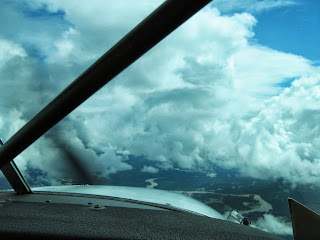So just over a week ago, we were wandering around the Jakarta airport with about three more bags than we could reasonably carry, trying to figure out the terminal shuttle system in a tropical downpour, with a collective Indonesian vocabulary of about two dozen words. Turns out there's an Indonesian word to describe people like us: "bule (pronounced: "buh'-leh")". Basically, it just means a big, bumbling, clueless white person (probably American). At least that's the best I can tell. The Latin American equivalent would be "gringo" and the North American equivalent would be "[insert your name here]". But that was a week ago. Seems more like a month ago considering all the new sights, sounds, smells, tastes (chocolate/avocado milkshake, anyone?), and experiences we've had. It's been great! A picture is worth a thousand words, so I'm just going to throw in a few pictures and bring you up to speed on our myriad experiences over the past week, in no particular order.

The church we attended on Sunday had a baptism after the service. Amazing to see the fruits of decades of missions work here on Borneo. This is what it's all about.
We had a chance to put our tourist hats on and visit an orangutan rehab facility. Turns out "orangutan" is an Indonesian word: Orang = person from; Utan = the jungle or forest
Connor isn't exactly sure what to think of these tropical downpours.
Connor hanging out with Abetnego, one of the MAF national staff. Turns out Connor speaks Indonesian just as fluently as English.
Last night, Abetnego took us (Aaron, our MAF host, and myself) out star gazing on the river in this little canoe with a small outboard motor. We couldn't see the stars so well, but we had a great view of the lightning all around us. But I must admit, it really was very peaceful to just get out in the middle of the river, cut the engine and enjoy the peace and quiet. The lightning show was fantastic. The best part? If we turned off all our flashlights, we couldn't see the 3" cockroaches scurrying around the hull of our stately vessel.
Another day of flying Borneo's pristine jungle rivers.
Weather adds yet another dimension to flying in Borneo and there was plenty of it on this day.
Adding some fuel at our first stop
The fuel truck
On to the next village with more weather to negotiate. This leg even featured rock spires poking up through the clouds, just to keep things interesting.
This particular leg we didn't have any passengers. Just Aaron, myself, and Aaron's spiffy helmet. Wait... helmet? Do I get one of those?
We hit a log on the landing here, so I got to check for water in the floats to verify their continued buoyancy. Check.
More weather. More rocks.
Adding more fuel. 30 gallons, to be precise. In five gallon increments, all by hand, on top of the aircraft, over the river. Oh yeah, and the fuel cans were covered with ants. And yes, the river sports crocodiles. This is Borneo. The dock agent wanted his picture with the "bule".
After a nine hour day, we were on our way home. One more cloud embankment to pick our way through and we were home free. If you can't get through the clouds, no problem. Just land on the river and spend the night in the jungle. You can always try again tomorrow.

The MAF program here in Palangkaraya is planning on adding an amphibious Kodiak aircraft to their floating fleet. This is specifically where we at Spokane Turbine Center come in, as we provide the initial transition training for this new aircraft. Flight days like this highlight the advantages of an airplane like the Kodiak here in Borneo. The Kodiak has several tools to display terrain (TAWS, terrain overlay, synthetic vision) and weather information (stormscope) which would have been particularly handy today. It also burns fuel that is much cheaper (jet fuel) and carries more than twice the payload. Today Aaron and I had to make three shuttle trips between two villages, which the Kodiak could have easily made in a single trip, saving time and money. It also flies about 35 miles per hour faster and has better takeoff and landing performance on the water than the 50+ year-old aircraft MAF currently operates here. We are excited to see how STC can partner with MAF-Palangkaraya as they transition to turbine aircraft operations.

Sadly, today was our last day in Palangkaraya. We have had a fantastic experience here, observing the float plane program and how STC might best serve their future training needs. Tomorrow we catch our flight to Tarakan, another city on Borneo, to spend four weeks with the MAF program there. We appreciate your prayers as we make the transition. Three flights and two connections over a span of eight hours. Who knows what adventures lie ahead?





















































